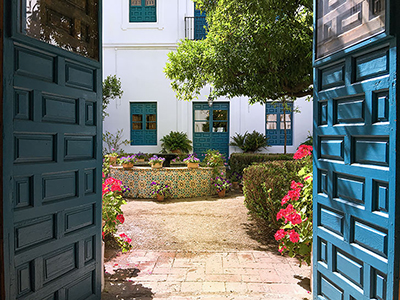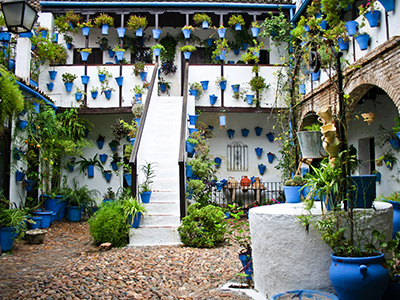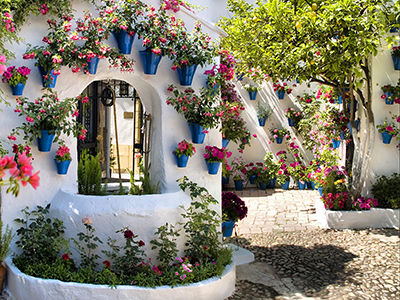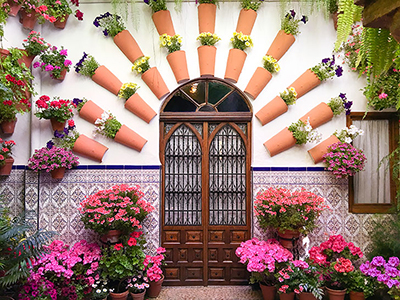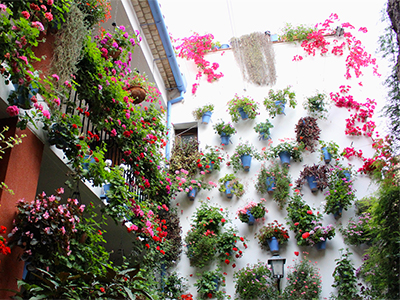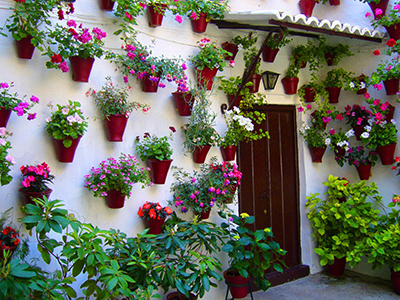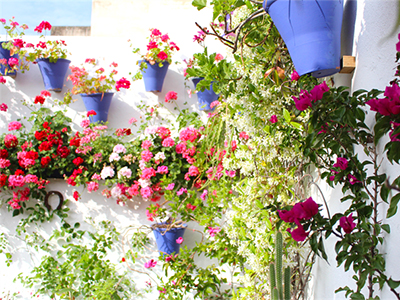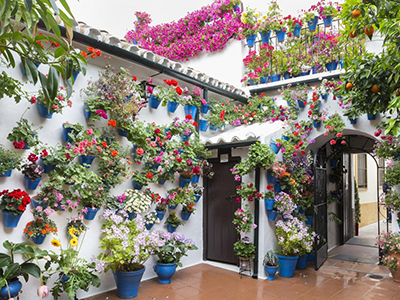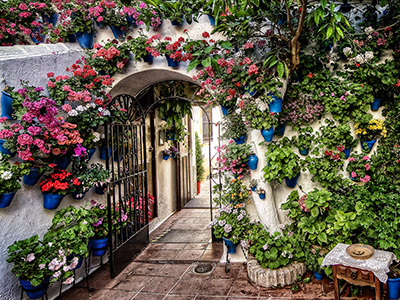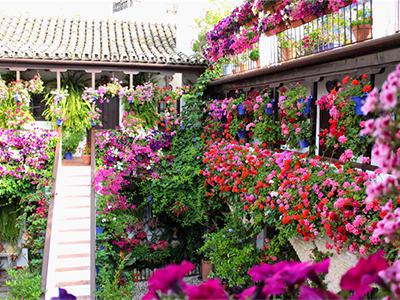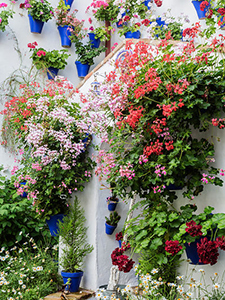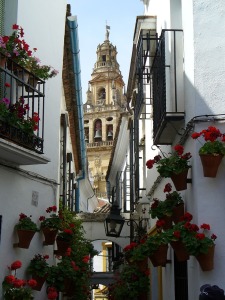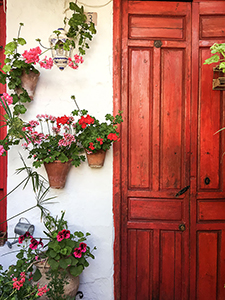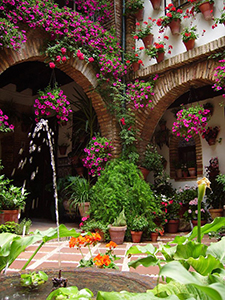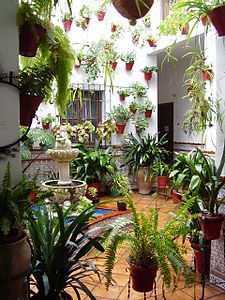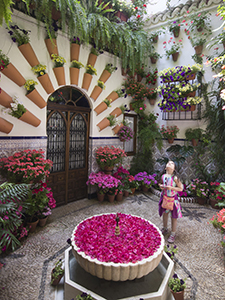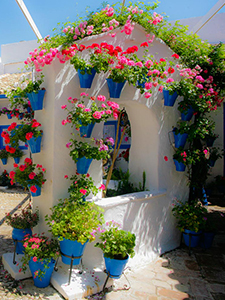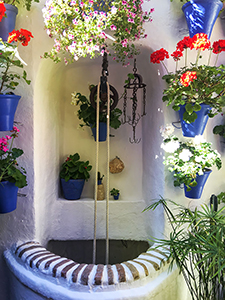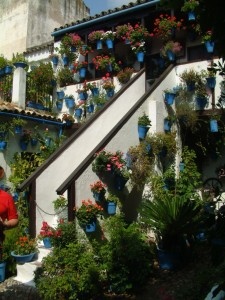The Patio Festival in Córdoba.
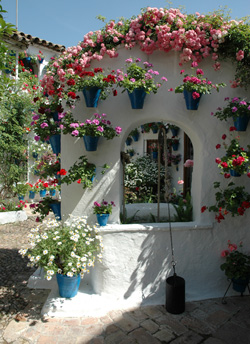 Every year in May, the city of Córdoba celebrates its traditional Córdoba Patio Festival. In this festival, patio owners decorate their ornate iron grills and balconies with plants and flowers; mainly gitanillas (ivy geraniums), geraniums and carnations. The Córdoba Patio Festival is a true representation of Andalusian folklore that manifests itself in its entire splendour in the early spring. Normally the patios are privately owned and unavailable for public viewing, but during the festival their doors open up for all to see by their proud owners. The best conserved and most beautiful patio is voted on and the winner is recognised not only with a monetary prize but also with the prestige and admiration of having the best patio in the city.
Every year in May, the city of Córdoba celebrates its traditional Córdoba Patio Festival. In this festival, patio owners decorate their ornate iron grills and balconies with plants and flowers; mainly gitanillas (ivy geraniums), geraniums and carnations. The Córdoba Patio Festival is a true representation of Andalusian folklore that manifests itself in its entire splendour in the early spring. Normally the patios are privately owned and unavailable for public viewing, but during the festival their doors open up for all to see by their proud owners. The best conserved and most beautiful patio is voted on and the winner is recognised not only with a monetary prize but also with the prestige and admiration of having the best patio in the city.
These patios have been constructed in Córdoba throughout the city's history, going back to Roman times and their use of the atrium, and today we can find some patios that date back to the 10th century. During that time Córdoba was the centre of Al-Andalus, the Muslim caliphate in the Iberian Peninsula and was its largest city with a half million inhabitants - much more than the present population of 330,000 people. These exotic patios were built by Arabic architects, following in the architectural footsteps of the Romans, and with these patios the concept of the oasis was exemplified; greenery and water, both essential for survival in the desert lands from which the Arabs originated, are represented. This feature also created a public space within the home creating a type of private “street”.
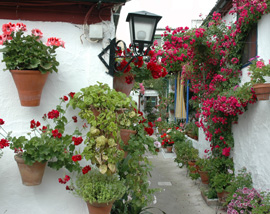 In the 13th century, Ferdinand III of Castile conquered Córdoba which provoked a massive exodus of the city’s inhabitants. Córdoba was a virtual ghost town with the city’s population falling to a meagre 25,000 inhabitants. The Christians that inhabited the city took over the best houses and sometimes uniting several smaller houses. These houses are known today as Solariega houses and maintain their original structures and Arabic patios. It was not until the end of the period of the Catholic Monarchs and the Renaissance that the patios began to incorporate Italian influences. It was at this time that "receiving patios" or courtyards started appearing. This is where visitors were met and the horse stalls were kept. The courtyard also gave access to the house which usually consisted of two floors: the lower floor was the summer dwelling and the upper floor the winter dwelling. The solariegas central courtyards are representative of the Renaissance influence with their decoration, fountains, columns and balconies.
In the 13th century, Ferdinand III of Castile conquered Córdoba which provoked a massive exodus of the city’s inhabitants. Córdoba was a virtual ghost town with the city’s population falling to a meagre 25,000 inhabitants. The Christians that inhabited the city took over the best houses and sometimes uniting several smaller houses. These houses are known today as Solariega houses and maintain their original structures and Arabic patios. It was not until the end of the period of the Catholic Monarchs and the Renaissance that the patios began to incorporate Italian influences. It was at this time that "receiving patios" or courtyards started appearing. This is where visitors were met and the horse stalls were kept. The courtyard also gave access to the house which usually consisted of two floors: the lower floor was the summer dwelling and the upper floor the winter dwelling. The solariegas central courtyards are representative of the Renaissance influence with their decoration, fountains, columns and balconies.
With the emergence of the bourgeoisie in the 18th and 19th centuries, new middle class construction seemed to imitate that of the older solariegas manors of the nobility, although to a smaller scale. Also during this time, foreign influences and decorations started to influence the courtyard patios: marble, central fountains, closed galleries in upper floors, etc.
By the 20th century, as a result of the migration from the countryside to the cities, the old solariegas houses were transformed into common apartments in which the rooms were rented out and the bathrooms, kitchens and other common areas were shared. Usually, these spaces were placed in the patio which was the common area accessible to all the residents.
Some of these old buildings have been returned to their original state. Nowadays they are museums, schools or other official centres that has contributed to the excellent conservation of the famous courtyard patios.
The City of Córdoba has created a map guide that makes finding these hidden treasures easy along with routes for finding these patios in each neighbourhood. This map is ideal for taking advantage of this springtime tradition.
Córdoba Courtyards during Christmas
It is not only the month of May when the Córdoba patios and courtyards are shown to the public. During Christmas they are also decorated with Christmas ornaments, poinsettias and lights; best of all they are open to visitors as well. During these festive days food samplings take place and Christmas carols are sung in the courtyards that welcome thousands of visitors who go to experience these enclosed pieces of paradise. And, as always, the best courtyard patio receives a prize.

